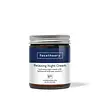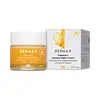What's inside
What's inside
 Key Ingredients
Key Ingredients

 Benefits
Benefits

 Concerns
Concerns

 Ingredients Side-by-side
Ingredients Side-by-side

Water
Skin ConditioningGlycerin
HumectantPersea Gratissima Fruit Butter
EmollientHelianthus Annuus Seed Oil
EmollientGlyceryl Stearate Se
EmulsifyingCetyl Alcohol
EmollientPrunus Armeniaca Kernel Oil
MaskingOlea Europaea Fruit Oil
MaskingStearic Acid
CleansingOryza Sativa Bran Oil
EmollientSodium Levulinate
Skin ConditioningSodium Anisate
AntimicrobialSodium Hyaluronate
HumectantAloe Barbadensis Leaf Juice
Skin ConditioningGlyceryl Caprylate
EmollientXanthan Gum
EmulsifyingAmorphophallus Konjac Root Extract
HumectantArgania Spinosa Kernel Oil
EmollientTocopherol
AntioxidantSodium Ascorbyl Phosphate
AntioxidantFerulic Acid
AntimicrobialLavandula Angustifolia Oil 0.045%
MaskingWater, Glycerin, Persea Gratissima Fruit Butter, Helianthus Annuus Seed Oil, Glyceryl Stearate Se, Cetyl Alcohol, Prunus Armeniaca Kernel Oil, Olea Europaea Fruit Oil, Stearic Acid, Oryza Sativa Bran Oil, Sodium Levulinate, Sodium Anisate, Sodium Hyaluronate, Aloe Barbadensis Leaf Juice, Glyceryl Caprylate, Xanthan Gum, Amorphophallus Konjac Root Extract, Argania Spinosa Kernel Oil, Tocopherol, Sodium Ascorbyl Phosphate, Ferulic Acid, Lavandula Angustifolia Oil 0.045%
Water
Skin ConditioningCaprylic/Capric Triglyceride
MaskingSodium Ascorbyl Phosphate
AntioxidantGlycerin
HumectantSodium Hyaluronate
HumectantCetyl Alcohol
EmollientEthylhexyl Palmitate
EmollientCetearyl Alcohol
EmollientCetearyl Glucoside
EmulsifyingCetyl Palmitate
EmollientSorbitan Palmitate
EmulsifyingSorbitan Oleate
EmulsifyingDiheptyl Succinate
EmollientCapryloyl Glycerin/Sebacic Acid Copolymer
Skin ConditioningPseudozyma Epicola/Nitrosomonas Europaea/Oil Ferment Filtrate
Skin ConditioningPrunus Armeniaca Kernel Oil
MaskingHelianthus Annuus Seed Oil
EmollientPrunus Amygdalus Dulcis Oil
Skin ConditioningEnterococcus Faecium/Saururus Chinensis Extract Ferment Filtrate
EmollientAspalathus Linearis Leaf Extract
Skin ConditioningGlycyrrhiza Glabra Root Extract
BleachingRosa Canina Fruit Oil
EmollientCamellia Sinensis Leaf Extract
AntimicrobialOlea Europaea Fruit Oil
MaskingRetinol
Skin ConditioningBakuchiol
AntimicrobialPanthenol
Skin ConditioningTocopheryl Acetate
AntioxidantXanthan Gum
EmulsifyingPotassium Sorbate
PreservativePhenoxyethanol
PreservativeEthylhexylglycerin
Skin ConditioningParfum
MaskingWater, Caprylic/Capric Triglyceride, Sodium Ascorbyl Phosphate, Glycerin, Sodium Hyaluronate, Cetyl Alcohol, Ethylhexyl Palmitate, Cetearyl Alcohol, Cetearyl Glucoside, Cetyl Palmitate, Sorbitan Palmitate, Sorbitan Oleate, Diheptyl Succinate, Capryloyl Glycerin/Sebacic Acid Copolymer, Pseudozyma Epicola/Nitrosomonas Europaea/Oil Ferment Filtrate, Prunus Armeniaca Kernel Oil, Helianthus Annuus Seed Oil, Prunus Amygdalus Dulcis Oil, Enterococcus Faecium/Saururus Chinensis Extract Ferment Filtrate, Aspalathus Linearis Leaf Extract, Glycyrrhiza Glabra Root Extract, Rosa Canina Fruit Oil, Camellia Sinensis Leaf Extract, Olea Europaea Fruit Oil, Retinol, Bakuchiol, Panthenol, Tocopheryl Acetate, Xanthan Gum, Potassium Sorbate, Phenoxyethanol, Ethylhexylglycerin, Parfum
Ingredients Explained
These ingredients are found in both products.
Ingredients higher up in an ingredient list are typically present in a larger amount.
Cetyl Alcohol is a fatty alcohol. Fatty Alcohols are most often used as an emollient or to thicken a product.
Its main roles are:
Though it has "alcohol" in the name, it is not related to denatured alcohol or ethyl alcohol.
The FDA allows products labeled "alcohol-free" to have fatty alcohols.
Learn more about Cetyl AlcoholGlycerin is already naturally found in your skin. It helps moisturize and protect your skin.
A study from 2016 found glycerin to be more effective as a humectant than AHAs and hyaluronic acid.
As a humectant, it helps the skin stay hydrated by pulling moisture to your skin. The low molecular weight of glycerin allows it to pull moisture into the deeper layers of your skin.
Hydrated skin improves your skin barrier; Your skin barrier helps protect against irritants and bacteria.
Glycerin has also been found to have antimicrobial and antiviral properties. Due to these properties, glycerin is often used in wound and burn treatments.
In cosmetics, glycerin is usually derived from plants such as soybean or palm. However, it can also be sourced from animals, such as tallow or animal fat.
This ingredient is organic, colorless, odorless, and non-toxic.
Glycerin is the name for this ingredient in American English. British English uses Glycerol/Glycerine.
Learn more about GlycerinHelianthus Annuus Seed Oil is the oil derived from the seeds of a Sunflower. Sunflower seed oil is non-fragrant. It is an emollient, meaning it helps to soften the skin.
Sunflower seed oil contains many fatty acids. The fatty acids found in sunflower seeds include (from highest amount to least): linoleic acid, myristic acid, palmitic acid, stearic acid, arachidic acid, oleic acid, and linolenic acid.
These fatty acids help the skin create ceramides. Ceramides play a role in repairing the skin barrier.
Helianthus Annuus Seed Oil helps moisturize the skin. This in turn helps the skin look more rejuvenated and smoother.
Sunflowers are rich in vitamin E.
Historians believe Indigenous cultures of North America domesticated sunflowers before corn. Thus they relied on sunflower oil for a variety of uses. One such use is moisturizing skin and hair.
Sunflower seed oil may not be fungal acne safe. We recommend speaking with a professional if you have any concerns.
Learn more about Helianthus Annuus Seed OilOlea Europaea Fruit Oil is the fixed oil obtained from the ripe fruit of the Olive. In other words - olive oil.
The primary contents of olive oil are glycerides of the fatty acids linoleic, oleic and palmitic.
Olive oil also contains antioxidants such as Vitamin E. Antioxidants may help reduce signs of aging by fighting unstable free-radical molecules. It also contains Vitamins A (retinol), D, and K.
The squalene in olive oil makes it a great emollient. Emollients help soothe and soften your skin by trapping moisture in. This makes olive oil a great skin moisturizer.
Studies show olive oil to have antibacterial and antifungal properties in low concentrations. Another study found olive oil irritated sensitive oily skin. We always recommend speaking with a professional about using this ingredient in your routine.
Due to the fatty acid content, this ingredient may not be fungal-acne safe.
Learn more about Olea Europaea Fruit OilThis ingredient is the oil from the apricot.
Apricot Kernel Oil is an emollient and helps soften skin. This is due to its fatty acid components. Some of these fatty acids include linoleic and oleic acid.
This ingredient also has antioxidant properties from Vitamins A, C, and E. Antioxidants help fight free-radicals. Free-radicals are molecules that may damage your skin cells. Besides being antioxidants, these vitamins provide plenty of skin benefits as well.
Learn more about Prunus Armeniaca Kernel OilSodium Ascorbyl Phosphate is a form of Vitamin C. It is the salt of ascorbic acid.
This ingredient is more gentle than ascorbic acid. It is also more stable when exposed to light and oxygen.
Vitamin C helps reduce redness, improve skin texture, reduce the effects of aging, reduce the visibility of dark spots, and brighten skin.
Your skin uses Vitamin C to produce collagen and collagen production plays a role in having a strong skin barrier and plump skin. As an antioxidant, this ingredient also helps reduce the signs of aging such as fine-lines and wrinkles.
VItamin C helps brighten skin by blocking the process of skin darkening.
In a 2011 study, Sodium Ascorbyl Phosphate was found to have antibacterial properties. This may help treat acne.
Read more about other types of Vitamin C:
Learn more about Sodium Ascorbyl PhosphateSodium Hyaluronate is hyaluronic acid's salt form. It is commonly derived from the sodium salt of hyaluronic acid.
Like hyaluronic acid, it is great at holding water and acts as a humectant. This makes it a great skin hydrating ingredient.
Sodium Hyaluronate is naturally occurring in our bodies and is mostly found in eye fluid and joints.
These are some other common types of Hyaluronic Acid:
Learn more about Sodium HyaluronateWater. It's the most common cosmetic ingredient of all. You'll usually see it at the top of ingredient lists, meaning that it makes up the largest part of the product.
So why is it so popular? Water most often acts as a solvent - this means that it helps dissolve other ingredients into the formulation.
You'll also recognize water as that liquid we all need to stay alive. If you see this, drink a glass of water. Stay hydrated!
Learn more about WaterXanthan gum is used as a stabilizer and thickener within cosmetic products. It helps give products a sticky, thick feeling - preventing them from being too runny.
On the technical side of things, xanthan gum is a polysaccharide - a combination consisting of multiple sugar molecules bonded together.
Xanthan gum is a pretty common and great ingredient. It is a natural, non-toxic, non-irritating ingredient that is also commonly used in food products.
Learn more about Xanthan Gum